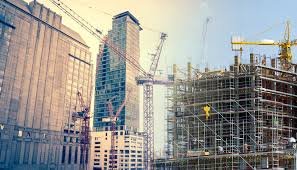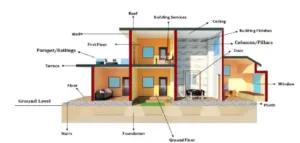Sustainable Construction Practices: Building for a Greener Future…
Sustainable construction practices aim to minimize the environmental impact of buildings and infrastructure while enhancing energy efficiency, resource conservation, and occupant well-being. As the world focuses on reducing carbon footprints and promoting eco-friendly alternatives, sustainable construction plays a key role in creating a greener future. Here’s a comprehensive overview of sustainable construction principles and strategies:
1. Energy-Efficient Building Design

- Passive Solar Design: Utilizing building orientation, window placement, and thermal mass materials to maximize natural heating, cooling, and lighting, reducing reliance on artificial systems.
- Insulation and Sealing: High-quality insulation and air sealing minimize energy loss, reducing heating and cooling needs. This leads to significant energy savings and a more comfortable indoor environment.
- Energy-Efficient Systems: Installing high-efficiency HVAC systems, energy-saving appliances, and LED lighting helps reduce overall energy consumption. Smart home systems further optimize energy use by controlling lighting, temperature, and other systems automatically.
2. Sustainable Building Materials

- Recycled and Reclaimed Materials: Using reclaimed wood, recycled steel, and other repurposed materials reduces the demand for new resources and minimizes waste.
- Locally Sourced Materials: Choosing materials produced locally reduces transportation emissions and supports regional economies. These materials are often better suited to local climates and environmental conditions.
- Sustainable Wood and Bamboo: Timber from sustainably managed forests and rapidly renewable materials like bamboo provide eco-friendly alternatives to traditional building materials.
3. Water Conservation Strategies

- Rainwater Harvesting: Collecting and storing rainwater for use in irrigation, toilets, or other non-potable systems reduces reliance on municipal water supplies.
- Greywater Systems: Reusing water from sinks, showers, and laundry for irrigation helps conserve freshwater resources.
- Low-Flow Fixtures: Installing water-efficient faucets, showerheads, and toilets minimizes water waste while maintaining comfort and functionality.
4. Waste Reduction and Recycling

- Construction Waste Management: Implementing strategies to reduce and recycle construction debris helps minimize landfill waste. Prefabrication and modular construction can reduce material waste significantly.
- Circular Economy Practices: Encouraging the reuse of building components at the end of a structure’s lifecycle reduces the environmental impact of demolition and disposal.
5. Renewable Energy Integration

- Solar Power: Solar panels are one of the most effective ways to generate renewable energy on-site, reducing dependence on fossil fuels and lowering greenhouse gas emissions.
- Wind Energy: In areas with sufficient wind resources, small-scale wind turbines can complement solar power and further reduce the environmental impact of buildings.
- Geothermal Energy: Geothermal systems use the Earth’s natural temperature for heating and cooling, providing a sustainable and energy-efficient alternative to conventional HVAC systems.
6. Green Building Certifications

- LEED (Leadership in Energy and Environmental Design): LEED certification sets standards for sustainable design, construction, and operation, encouraging energy efficiency, waste reduction, and improved indoor air quality.
- BREEAM (Building Research Establishment Environmental Assessment Method): BREEAM certification evaluates the environmental performance of buildings, focusing on energy, water, materials, and health.
- Living Building Challenge: A rigorous green building certification focused on creating self-sustaining buildings that have a positive environmental impact.
7. Sustainable Site Selection and Land Use

- Brownfield Redevelopment: Revitalizing previously developed or contaminated sites reduces pressure to develop new, natural areas, preserving ecosystems and reducing urban sprawl.
- Permeable Surfaces: Using materials like permeable concrete, pavers, or gravel allows rainwater to filter into the ground, reducing runoff and promoting groundwater replenishment.
- Green Roofs and Living Walls: These features improve insulation, reduce heat island effects in urban areas, and provide habitats for wildlife.
8. Indoor Environmental Quality (IEQ)

- Natural Ventilation: Designing buildings to maximize airflow and incorporate fresh air reduces the need for mechanical ventilation and enhances indoor air quality.
- Daylighting: Strategically placing windows, skylights, and reflective surfaces to enhance natural light reduces the need for artificial lighting and improves occupant well-being.
- Low-VOC Materials: Using low-emission paints, adhesives, and finishes reduces harmful indoor pollutants, creating a healthier environment for occupants.
9. Climate-Resilient Design

- Durability and Adaptability: Designing buildings to withstand extreme weather events, such as floods, hurricanes, and heatwaves, makes them more resilient to climate change. This can include using materials resistant to water damage or ensuring buildings are adaptable for future changes.
- Stormwater Management: Integrating features like bioswales, rain gardens, and permeable pavements helps manage stormwater runoff and reduces the risk of flooding.
10. Biodiversity and Green Landscaping

- Native Plants: Incorporating native species in landscaping reduces water use and provides habitat for local wildlife. Native plants are typically better suited to the local climate and require fewer resources to maintain.
- Urban Forestry: Planting trees around buildings reduces energy costs by providing shade, helps mitigate the heat island effect in cities, and captures carbon from the atmosphere.
Benefits of Sustainable Construction
- Environmental Impact: Sustainable construction reduces resource consumption, lowers carbon emissions, and minimizes waste.
- Economic Savings: Energy-efficient designs, water conservation systems, and renewable energy installations often lead to lower utility costs over the life of the building.
- Health and Well-Being: Improved indoor air quality, natural lighting, and non-toxic materials create healthier spaces for occupants.
- Resilience: Buildings designed with sustainability and resilience in mind are better equipped to handle environmental challenges, such as extreme weather and energy shortages.
- Long-Term Value: Green buildings tend to have higher market values and attract eco-conscious tenants or buyers.
Conclusion
Sustainable construction practices are essential to mitigating climate change, conserving natural resources, and improving the quality of life for building occupants. By adopting energy-efficient designs, using sustainable materials, integrating renewable energy, and prioritizing waste reduction, the construction industry can build a greener, more sustainable future. The shift toward sustainable construction is not just an environmental necessity but also a way to create resilient, healthier, and economically viable communities for future generations.











Add comment